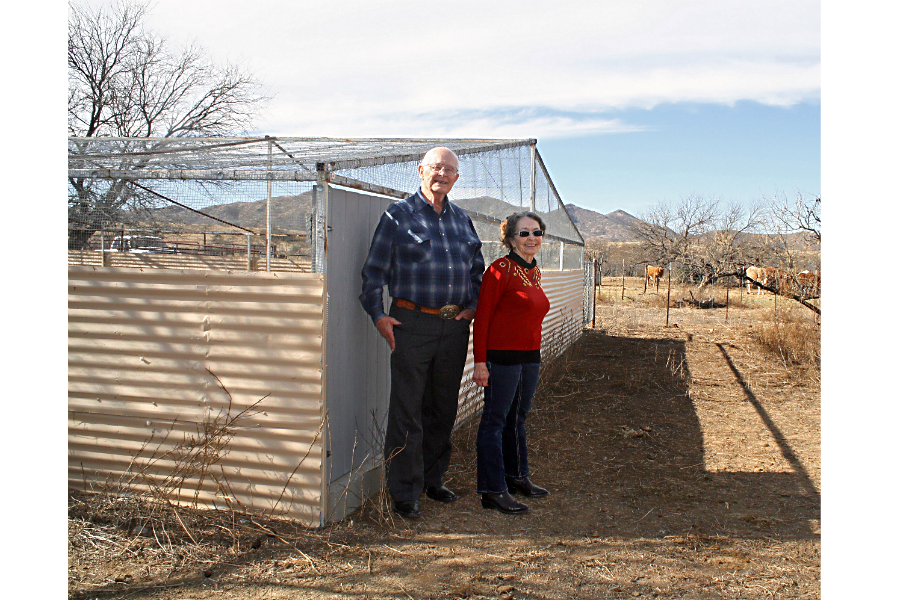Feds, ranchers aren’t always at odds: how they’re finding common ground
Loading...
| Arivaca, Ariz.
When Jim and Sue Chilton gaze west on their 50,000-acre, southern Arizona ranch, they see the classic cowboy panorama: grassy hills, grazing horses, and a skittish herd of newly weaned calves. But when they look east, the scene isn't so typical: A shallow, concrete pond stretches beneath a wire-mesh canopy, its murky waters designed to harbor a threatened amphibian called the Chiricahua leopard frog.
For many ranchers like the Chiltons, who have traditionally viewed the federal Endangered Species Act with trepidation and disdain, hosting an imperiled frog would once have been unthinkable. Out here, after all, it's well known that finding an endangered plant or animal on your range can lead to an invasion of government biologists and hobbling restrictions. Folks might suddenly find their cattle locked out of prime pastureland, or see fences go up around streams and ponds.
But although you wouldn't know it by the recent standoff at Oregon's Malheur National Wildlife Refuge, some long-simmering tensions between ranchers and the government have actually cooled in recent years. Instead of seeing ranchers as trenchant adversaries, government agencies are increasingly courting them as conservation partners. And in some cases at least, landowners are agreeable to such arrangements, finding that the partnerships can benefit them as well.
Consider these government programs:
- The Conservation Stewardship Program, administered by the US Natural Resources Conservation Service, provides technical guidance on managing cattle herds to improve native grasslands, wildlife habitat, and soil quality.
- The Conservation Service also oversees the Environmental Quality Incentives Program, which helps fund the transition to organic agriculture by ranchers and farmers.
- Some states offer their own programs geared toward helping ranchers improve their property. Rancher Jim Crosswhite, for one, received grant funding through the Arizona Department of Environmental Quality to restore crucial stream habitat for a threatened native fish.
What the Chiltons are participating in is a Safe Harbor Agreement with the US Fish and Wildlife Service (FWS). In exchange for helping with the recovery of endangered or threatened species, participants in these agreements receive protection against additional FWS restrictions on how they use their land. The agreements can last for a decade or be in perpetuity, and they often include enticements such as easements and grant-funded habitat improvements.
First introduced in 1995 to protect the red-cockaded woodpecker in North Carolina, Safe Harbor has grown to include more than 600 landowners across 26 states. Collectively, they have devoted more than 5.2 million acres to the protection of nearly 100 species, from black-footed ferrets to golden-cheeked warblers.
The numbers have reached a point where the government and ranchers can say they’ve found some significant common ground. A key factor in the trend? Some point to a more collaborative approach by the government.
Programs such as Safe Harbor mark a "realization by government agencies that top-down programs by elite scientists and federal agencies weren't always attuned to people on the ground or to local communities," says Nancy Langston, a professor of environmental history at Michigan Technological University in Houghton.
The Chiltons have in fact opposed many endangered-species listings that might threaten rural agriculture. And as a past state game and fish commissioner, Ms. Chilton ardently fought reintroduction of the Mexican gray wolf and species protections that impinged on ranchers, characterizing them as "biologically fruitless efforts."
But in 2008, convinced that the Chiricahua leopard frog deserved protection and that they could help without compromising their ranch, the Chiltons signed a Safe Harbor Agreement. The result is the $20,000 frog pond, or refugium, which they paid to build.
"Sue and I recognized that this was a species that was truly endangered," Mr. Chilton says. "Everybody likes animals. No one wants to harm them or eliminate them. If ranchers have positive things they can do without risking their livelihood, then they love to do it."
FWS seems eager to tap such goodwill. "Ranchers are inherently stewards of the land," says Steve Spangle, the agency's Arizona wildlife field supervisor. "I think most of them are proud to have endangered species on their ranches, as long as they're not going to get hammered for it."
But not everyone is on board. Kierán Suckling is executive director of the Center for Biological Diversity, a group based in Tucson, Ariz., that is best known for going to court to enforce the Endangered Species Act. Mr. Suckling says that government agencies claim success with Safe Harbor by pointing to the number of private landowners enrolled in the program. "What you want to hear is that the number of species has gone up 75 percent," he says, "not that the number of ranchers has gone up 75 percent."
In 2003, Mr. Crosswhite signed Arizona's first Safe Harbor Agreement, to protect the threatened Little Colorado spinedace in three miles of stream running through his EC Bar Ranch in Nutrioso. He praises the program for helping restore the creek and the tiny fish. Subsequent grants helped him plant thousands of willows and build an eight-foot fence to keep out abundant, stream-trampling elk.
Still, he concedes that some of his rural neighbors remain skeptical of government involvement. "If I've heard any complaints," says Crosswhite, "it's from people who complain that I'm getting public funding, and that doesn't seem right to them. They actually resent the fact that you participate in the programs."
But he sees it differently: "If you have a species that's threatened with extinction, you have the responsibility to do something about it."







